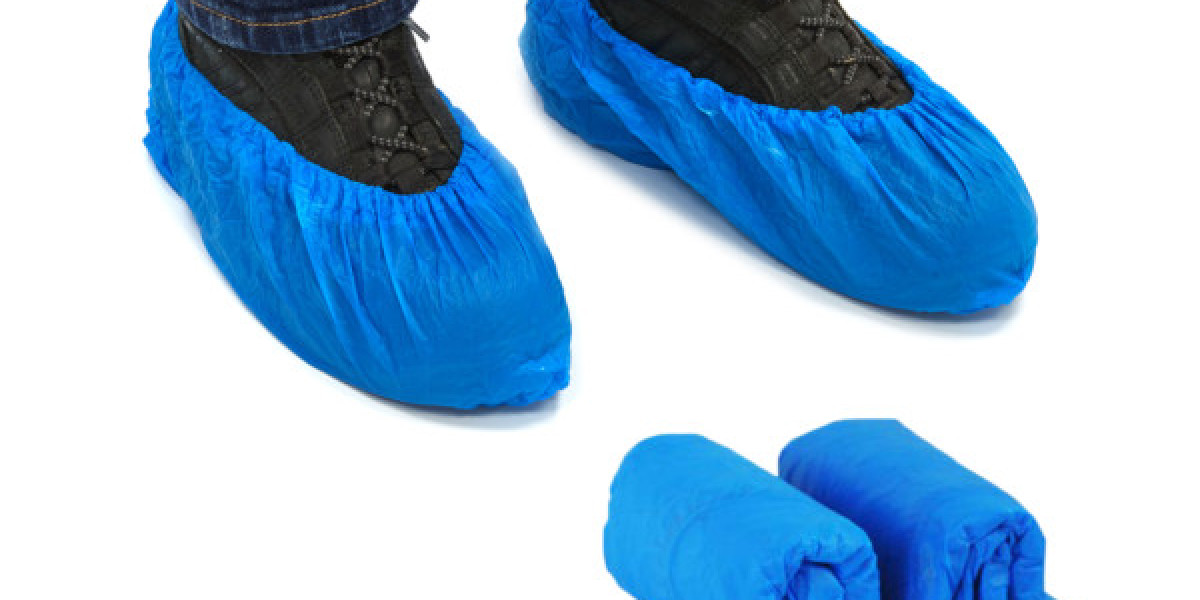In the world of food manufacturing, cleanliness is king. It's a realm where hygiene standards are not just guidelines; they are critical to ensuring safety and quality. Recently, one item has emerged as a game changer in this domain: Disposable Shoe Cover. As production lines become more efficient and consumer demands grow, these disposable covers have quickly gained traction. But what’s driving their rise to prominence? From preventing contamination to enhancing workplace efficiency, single-use shoe covers are revolutionising the way we approach cleanliness in food production facilities. Let’s dive into why this seemingly simple accessory is becoming essential for manufacturers everywhere!
Hygiene and Contamination Risks in Production Zones
Hygiene in production zones is paramount. Even the smallest oversight can lead to significant contamination risks. Microorganisms thrive in environments where food is processed, making strict protocols essential for maintaining food safety.
Foot traffic introduces various contaminants, including dirt, dust, and harmful bacteria. Regular shoe soles can carry pathogens that pose serious threats to food safety. This risk escalates when employees move between different areas of a facility. Single-use shoe covers act as a barrier against these hazards. They block unwanted particles from entering sterile zones, ensuring products remain uncontaminated.
Moreover, they promote a culture of cleanliness among staff members. When everyone adopts this practice, it fosters accountability for hygiene standards across the board. As regulations tighten and consumer expectations rise, adopting effective solutions like single-use shoe covers becomes increasingly imperative for all food manufacturers seeking excellence in safety and quality.
Regulatory Compliance in Food Processing Facilities
Regulatory compliance is critical in food processing facilities. Strict guidelines set by organisations such as the FDA and USDA dictate hygiene standards that must be adhered to. Single-use shoe covers play a vital role in maintaining these standards, preventing contamination from foot traffic.
Using disposable footwear protection helps companies adhere to Good Manufacturing Practices (GMP). These practices ensure that products are safe for consumption. When workers change into single-use shoe covers upon entering production areas, it minimizes the risk of transferring allergens, bacteria, or other contaminants.
Failure to comply with regulations can result in severe repercussions, including fines or facility shutdowns. Implementing single-use shoe covers not only addresses compliance but also demonstrates a commitment to quality and safety within the manufacturing process. This proactive approach enhances brand reputation while safeguarding public health.
Comparing Disposable and Reusable Footwear Protection
When it comes to footwear protection in food manufacturing, the choice between disposable and reusable options is crucial. Single-Use Shoe Covers are often favoured for their convenience and ease of use. They eliminate the need for cleaning, reducing labour costs associated with maintenance. These single-use covers help ensure that any potential contaminants from outside the production area do not compromise product safety.
On the other hand, reusable shoe coverings may appeal to businesses looking at long-term sustainability. However, they require thorough cleaning and regular inspection to ensure effectiveness against contamination risks. This added responsibility can lead to increased operational costs if not managed properly.
Ultimately, each option has its pros and cons depending on specific needs within a facility. The rising preference for single-use shoe covers reflects an industry trend prioritizing hygiene above all else while simplifying compliance efforts. Businesses will continue evaluating these factors as they strive for efficiency and cleanliness in their production zones.
Material Innovation in Shoe Covers Disposable
Recent advancements in materials have revolutionized the design of Shoe Covers Disposable. Manufacturers are now utilizing lightweight, breathable fabrics that offer enhanced comfort while ensuring maximum protection against contamination. These innovative materials help maintain a safe environment by preventing dirt and bacteria from entering production zones.
Additionally, many Single-Use Shoe Covers feature slip-resistant soles made from advanced polymers. This provides better traction on wet or slippery surfaces, reducing the risk of accidents in food processing facilities. Such innovations enhance safety protocols while addressing hygiene concerns.
Moreover, eco-friendly options have emerged within the realm of Single-Use Shoe Covers. Biodegradable materials are being adopted to minimise environmental impact while maintaining performance. This shift not only meets regulatory requirements but also appeals to companies seeking to achieve sustainability in their operations.
Integration into Standard Operating Procedures
The integration of single-use shoe covers into standard operating procedures is more than just a trend; it reflects an evolving understanding of hygiene practices in food manufacturing. By establishing clear guidelines for footwear protection, facilities can ensure that all workers are equipped to maintain cleanliness standards.
Training programs play a vital role here. Employees should be educated on the importance of wearing Single-Use Shoe Covers and how they contribute to overall safety. Regular reminders and updates about protocols keep hygiene top-of-mind.
Moreover, monitoring compliance with these procedures helps reinforce their importance. Facilities that implement checks or audits related to the use of protective gear often see improved adherence among staff members. By incorporating single-use shoe covers into daily routines, companies foster a culture that prioritises safety and quality. This shift not only protects products but also builds consumer trust—a crucial element in today’s competitive market landscape.
Improving Safety Protocols Across Workstations
The implementation of single-use shoe covers significantly enhances safety protocols within food manufacturing environments. By creating a barrier between footwear and production areas, these covers reduce the risk of contaminants entering sensitive zones. This simple measure can effectively prevent cross-contamination during various stages of food processing.
Moreover, integrating Single-Use Shoe Covers into daily routines ensures that all employees adhere to consistent hygiene practices. Staff members are reminded to prioritise cleanliness every time they enter the production floor, which helps foster a culture of safety throughout the facility.
Routine training sessions emphasizing the importance of using single-use shoe covers also contribute to heightened awareness among workers. As employees recognise their role in maintaining overall product integrity, they become more engaged in following safety measures across workstations. This proactive approach not only protects products but also reinforces accountability within teams working in high-stakes environments.
Ease of Distribution and Implementation
The ease of distribution and implementation is a significant factor in the rising popularity of single-use shoe covers. These lightweight, disposable options are simple to stock and can be easily distributed throughout food manufacturing facilities. Their compact packaging allows for efficient storage, making them readily available whenever needed.
Training staff on their use is straightforward. Employees can quickly learn how to do these covers as part of their standard procedure upon entering production zones. This simplicity reduces the risk of contamination right from the start.
Moreover, implementing a single-use system minimizes the burden on facility cleaning protocols. There’s no need for extensive washing or drying processes associated with reusable footwear protection, which saves both time and labour costs. As manufacturers prioritise hygiene, safety, and efficiency in their operations, adopting single-use shoe covers appears to be a logical step forward in enhancing overall workplace health standards.
Cost-Effectiveness of Shoe Protection Covers
Shoe Protection Covers offer an economical solution for food manufacturers prioritising hygiene. These disposable items eliminate the need for constant cleaning and maintenance associated with reusable footwear. By using single-use options, facilities can reduce labour costs while ensuring a consistently clean environment.
Additionally, the cost of replacing soiled or damaged reusable footwear adds up over time. Single-use shoe covers offer predictable budgeting since they are purchased in bulk and discarded after use. This straightforward approach simplifies expense tracking.
Investing in single-use shoe protection also minimises the risk of contamination that could lead to costly product recalls or health violations. The financial implications of maintaining high safety standards far outweigh any initial investment in single-use gear, making it a smart choice for food processing operations committed to efficiency and cleanliness.
Support for HACCP and Other Food Safety Systems
The implementation of single-use shoe covers plays a crucial role in supporting HACCP (Hazard Analysis and Critical Control Points) and other food safety systems. These systems rely on strict hygiene protocols to ensure that contaminants do not compromise food products. By utilizing disposable footwear protection, facilities can minimize the risk of cross-contamination from employees' shoes.
Single-use shoe covers offer an extra layer of protection in environments where cleanliness is crucial. They help prevent foreign materials, such as dirt or bacteria, from entering production areas. This proactive approach aligns with HACCP principles, promoting safer food handling practices throughout the facility.
Furthermore, these shoe covers are easily integrated into existing training programs for staff members. Employees can quickly adapt to using them as part of their daily routines, reinforcing a culture of safety within the organization. When workers understand the importance of protective gear, compliance with food safety standards naturally improves.
Environmental Considerations in Single-Use Gear
The rise of single-use shoe covers in the food manufacturing industry has sparked discussions about their environmental impact. While these products enhance hygiene, they also generate waste. Understanding the balance between safety and sustainability is essential for modern facilities.
Innovations are emerging to address these concerns. Many manufacturers now produce biodegradable or eco-friendly materials for Single-Use Shoe Covers. This shift helps reduce landfill contributions while maintaining necessary sanitation standards.
Facilities can further enhance their green initiatives by implementing recycling programs specifically for used shoe covers. Engaging staff in sustainable practices promotes a culture of responsibility, combining operational efficiency with environmental stewardship.
Conclusion
The rise of Disposable Shoe Cover reflects a growing commitment to hygiene in food manufacturing. As facilities face increasing scrutiny regarding cleanliness, these disposable solutions provide peace of mind. They help maintain high standards across production zones. Embracing single-use options not only supports compliance with regulatory frameworks but also enhances safety protocols within workplaces. With innovative materials and designs, these covers are more effective than ever at preventing contamination. This promotes a safer environment for both employees and consumers. As the industry evolves, adopting practices like these becomes essential for maintaining reputation and trust. The shift toward single-use shoe covers marks a significant step forward in safeguarding our food supply chain while maintaining operational efficiency.
FAQs
Addressing common questions about single-use shoe covers can help clarify their importance and functionality in the food manufacturing industry.
What are Shoe Covers Disposable made from?
Shoe Covers Disposable are typically made from materials like polyethylene or polypropylene. These materials provide a barrier against contaminants while remaining lightweight and comfortable to wear.
How often should I change my shoe covers?
Shoe covers should be changed as needed, especially when moving between different production areas. Frequent changes help maintain hygiene standards and minimise the risk of contamination.
Are single-use shoe covers environmentally friendly?
While they do contribute to waste, many manufacturers are focusing on developing biodegradable options. It's essential to look for brands that prioritize sustainability without compromising safety.
Can reusable footwear protection replace disposable ones?
Reusable options exist but may not offer the same level of convenience and hygiene as disposables. Single-use shoe covers eliminate cleaning concerns, ensuring fresh protection every time.
Where can I find reliable suppliers of single-use shoe covers?
Reliable suppliers can often be found online through specialised distributors focused on food safety equipment or local industrial supply companies that cater to the food processing sector.
Related Business Listings |







